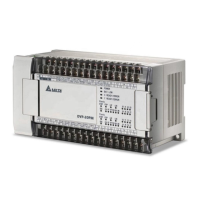6 Basic Usage of Motion Instructions and G-codes
DVP-20PM Application
Manual
6-30
Motion
instruction
number
Applicable model
20PM
11
SINTR
X P
1
/
P
2
F V
Inserting a single speed
Word device Double word device
K H D KK HH DD
P
1
P
2
V
Note: The instruction supports devices. The
devices supported can be modified
by V devices can Z devices. Please
refer to the specifications for the
DVP-20PM series motion controller
used for more information about the
device ranges available. The
instruction can be followed by an
M-code instruction.
Explanation
P
1
: Additional distance on the X-axis; P
2
: Additional distance on the Y-axis; V:
Operation speed
Maximum V=V
MAX
The first operand of SINTR can be either the X-axis or the Y-axis for single speed
positioning with additional distance.
Range of parameters: (16-bit) K=-32,768~32,767; H=0~FFFF; D=0~9,999;
(32-bit) KK=-2,147,483,648~2,147,483,647; HH=0~FFFFFFFF; DD=0~9,998
Acceleration/deceleration time and bias speed can be set in special data
registers.
Acceleration/deceleration time increases or decreases in proportional to the
setting of V
MAX
.
The 16-bit devices and 32-bit devices can be used together.
Timing diagram
T
ACC
T
DEC
V
MAX
V
BIAS
Start
DOG
Speed
Time
Operation speed V(I)
Additional
distance
When SINTR is enabled, the operation speed will start from the V
BIAS
set,
accelerate to the V (I) set, and operate stably. When the execution encounters
DOG’s signal, it will follow the additional distance set by the instruction and
complete the positioning process.
Both additional distance and moving speed are required, and therefore there are
2 operand combinations for SINTR.
No. Motion instruction Combination of operands
1
P
1
F V
2
SINTR
Y P
2
F V

